It can seem like an eternity for chicks to hatch in your incubator or in a clutch of eggs beneath a hen. Once you notice the first peck hole in the egg the excitement builds and you call for everyone else on the homestead to come watch and share the joy of new life.
But, sometimes, a chick gets “stuck” in the egg, and it seems like it’s never going to make its way out on its own.
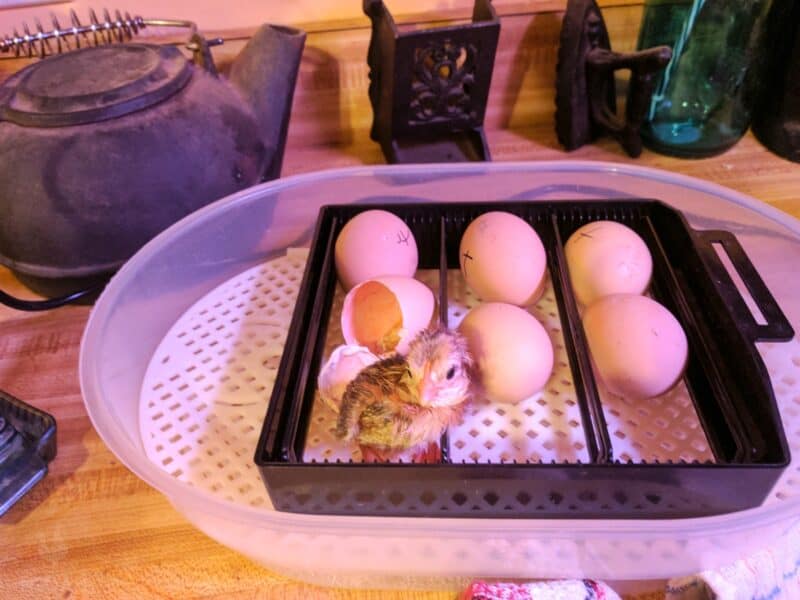
Usually – perhaps the bulk of the time, if the chick is left alone it will eventually make its way out of the egg all on its own… but it could take hours. Other times, a chick could be in distress, ill, or too exhausted to complete the hatching process, and simply give up and die.
Your instincts tell you to help the adorable chirping little struggling chick immediately, but that is definitely not always the best course of action.
Should You Help a Chick Hatch From an Egg?
Yes, sometimes. First, you need to learn how to tell if a chick that is stuck in the egg actually needs help hatching, and only then proceed with extreme caution to get it out. Even if you are careful and the chick requires human intervention to hatch from the egg, it can be harmed in the process.
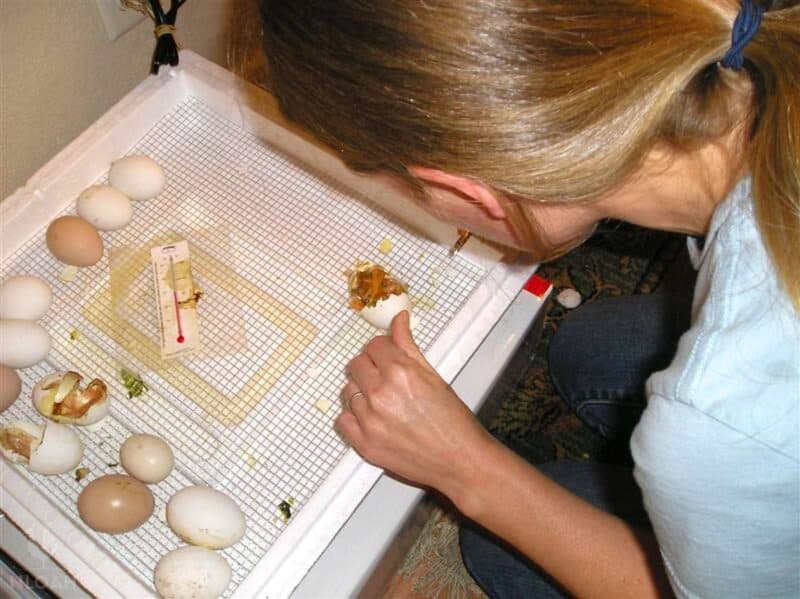
When You Should Consider Helping It
When everything works as it is supposed to, once a baby chick has pipped the first hole in the eggshell it will come out on its own in no longer than 24 hours. Unless there are visible signs of injury to the chick, like blood, do not try to help it hatch before the 24-hour mark.
In a nutshell, you should only help a chick hatch if it’s still struggling after 24 hours. If you decide to do it, you have to be very – one wrong move and your chick could bleed to death!
Some chicks make their way out of the egg in record time, but others can take considerably longer.
Comparing hatching times is helpful to learn more about the process and to discover an average hatching time for a single clutch of eggs, but expect the hatching times to vary from slightly to greatly.
Some chicks peck constantly, while others might take a break – and a nap, for hours in-between each little crack they make in their protective eggshell.
It can be hard to curtail your excitement as the end of the 21 day (or so) incubation period comes to an end.
Once that first chick is out of the egg and wobbling around, the eagerness to see all of the baby chicks come out can get quite intense – especially if you have equally excited children also peeking into the incubator window.
Before taking a drastic step to help a chick out of its eggs, answer these simple questions first…
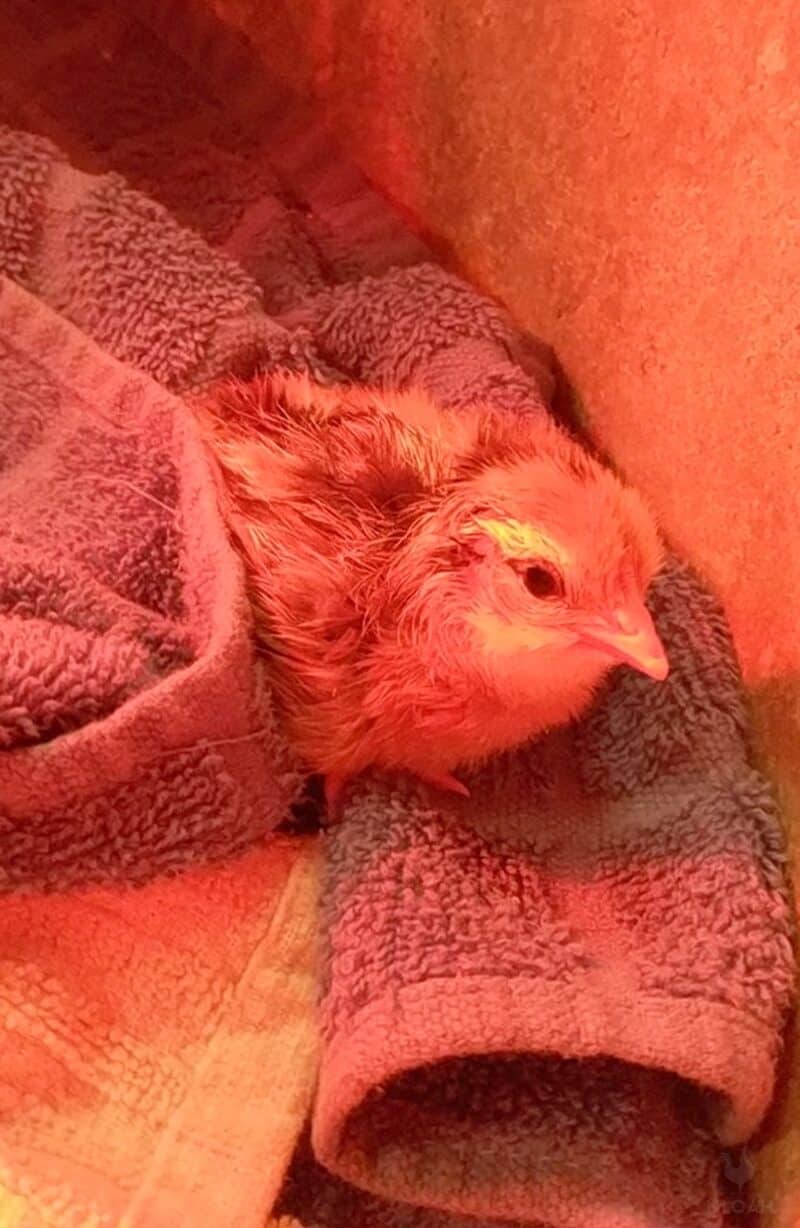
What Are The Chicks In The Other Eggs Doing?
Look in the incubator and see if any other chicks are showing signs of pipping – even if some have already hatched. The opening and closing of the lid will alter both the temperature and humidity levels inside and can impact hatching.
If you have been in and out of the incubator several times to get chicks out, the others may have just gotten chilled, and need to warm up again before going back to work.
The membrane can “shrink wrap” itself around the chick when these environmental changes occur, so minimize opening up the incubator unless it is absolutely necessary.
Depending upon the type of incubator you have, there is no real reason to immediately remove the chicks, they have the air and nutrients they need to survive inside most incubators for a full 24 hours.
Some chicks are over-achievers, so having one or two hatch and then a big lull in-between the next ones is really not uncommon.
Has The Chick Been Lethargic for More Than Two Hours Straight?
If the struggling chick shows signs of being lethargic for more than two hours, it may have given up the process entirely, and died or is near death.
If this happens and other eggs are still unhatched inside of the incubator, it is probably best to leave the unhatched egg right where it is to avoid causing membrane shrinkage that could harm the other chicks.
Is The Chick Still Trying To Fight Its Way Out Of The Egg?
If the struggling chick is still trying to get out of the egg but getting nowhere fast, help truly could be necessary. Just remember, there could be a health reason why the chick cannot hatch, and opening the incubator can harm other chicks, so choose wisely before reaching inside the incubator.
The loss of one chick is sad, but losing the rest of the eggs is going to be a lot worse. Letting nature take its course is emotionally hard, but sometimes it is the most humane option.
Is There Blood?
Look for visible signs of blood. If the struggling chick has not yet absorbed all of the yolk in the egg and there are either blood present or visible veins, resist the urge to do an emergency chicken delivery. The best chance at survival a chick in this state will have is on its own.
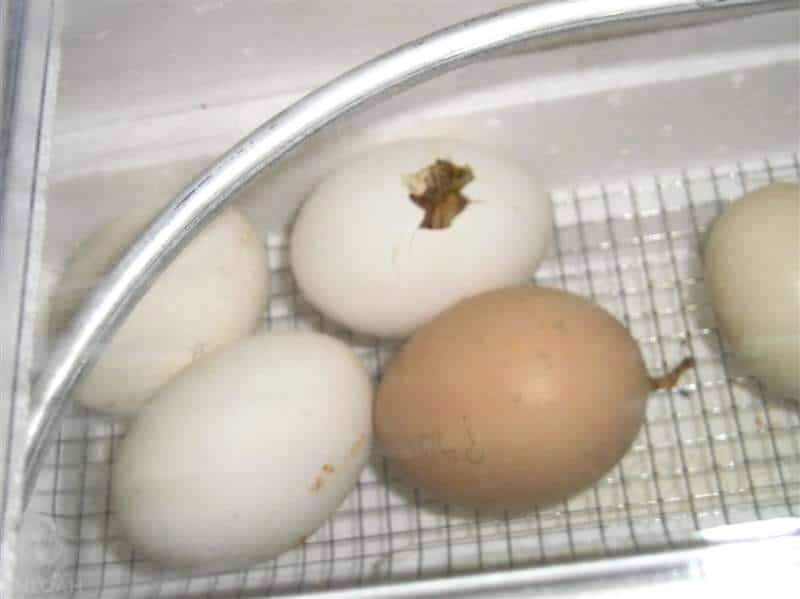
How Long Has The Chick Been Trying To Hatch?
Once you’re past the 24-hour mark and the chick still has not hatched from the egg, chances are great that it is not going to because it was simply not strong enough to survive.
Leaving the egg inside the incubator until the others hatch is likely the best option to avoid causing problems for other chicks.
In the video below you can clearly see the membrane left on the inside of an egg that hatched to get a better idea of how thick a wall a chick must get through:
The black “X” on each egg was placed there so that I could know for sure they were turning properly via the automatic arm attachment in the incubator.
Why Do Chicks Get Stuck In Their Eggs?
There could be many reasons why a chick cannot hatch on its own, but there are two that are far and away the most common.
Weakness
Breaking through the eggshell is a whole lot of physical labor for the newborn chick.
Even though the shell seems quite fragile to us, to fully grasp how difficult it can be for a chick to hatch you must compare the process to the work a momma and baby partake in moving the little one from the birth canal to the big wide world during labor.
Hatching from a shell is an amazingly strenuous task, and some chicks simply get exhausted quicker, and take longer periods of time than others.
Humidity
Fluctuating or low humidity levels in the incubator can also significantly impact the hatching process – especially if you are incubating ducks or guineas and not chickens.
If the humidity levels are too high, a chick can actually drown inside of the egg. If humidity levels are too low, hatching might never occur, or cause a chick to be ill-formed or too weak to complete the process.
Humidity levels in an incubator should be kept at roughly 50% for the first 18 days and then increased to 65% during the remaining days of incubation for the best chance of hatching healthy chicks that can break through the eggshell entirely on their own.
Humidity needs to be increased so the membrane that houses the chick inside of the shell does not become so hard that the chick cannot penetrate it with its beak.
How to Safely Help a Chick Hatch
Equipment
- tweezers
- washcloths
- Bowl
- plenty of light
Ingredients
- 1 bowl warm water
Instructions
- Fill a bowl with warm but not hot water.
- Place a washcloth over the bowl so it touches the water – but just barely. Think of it as a soft safety net for the chick if you can get it out of the egg safely.
- Carefully lower the chick in the egg onto the washcloth and even more gently attempt to moisten the membrane at all points where it is attached to the chick.
- Using another washcloth that has also been slightly dampened with warm water, fold it over the chick in the egg for a few moments and then remove it.
- Repeat this process numerous times to weaken the membrane. This often requires extreme patience – at least in my opinion, but is essential to helping the chick hatch. Do not, under any circumstance, try to pull the membrane off of the chick, even if it appears to be smothering. Doing so can not only tear the chick’s tender skin but rip its veins.
- You can gently try to break parts of the eggshell with tweezers, if it seems vital to getting the chick out, and to reach more membranes. If the shell will not crack easily that usually means the membrane is still too dry, and needs to moisten again with the cloth again – maybe multiple times.
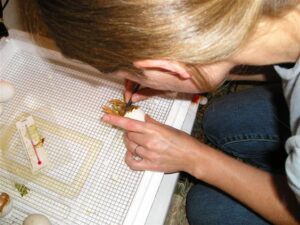
- You can use either the tweezers or your fingers to carefully and slowly detach only moistened membrane from the chick – if absolutely necessary because it is still struggling. ONLY do this with a moistened membrane that lifts away easily.
- If the water in your bowl starts to get lukewarm or cold, replace it with more warm water.
- If you get a live chick out of the shell, gently wrap a dry washcloth around it so it does not get chilled, and pat it dry as thoroughly and quickly as you can.
- Return the chick to the incubator as quickly as possible so it can get warm and stay warm.
The survival rate of chicks hatched with human intervention fluctuates greatly depending on how long and hard the chick struggled, how much help was needed, and its health before it even tried to hatch.
I have had one out of four chicks survive after having to help them hatch. My little chick was one of the lucky ones that was not stuck in the egg because of poor overall health or deformities and went on to become a great laying hen.
The best way to ensure a good clutch of eggs that can hatch all on their own is to monitor heat and humidity levels closely throughout the incubation process, and refrain from opening the lid to the machine until it is essential to do so.
What Happens if You Help a Chick Hatch?
If you find a chick that has hatched or is in the process of hatching, it is best to leave it be. That said, in some cases, it is necessary to help the chick out. Here are some tips to care for your chick after you’ve helped it hatch.
How Long Can a Chick Stay Without Food After Hatching?
A newly hatched chick will typically spend its first few days absorbing the yolk that it was born with. This process is known as “yolk sac absorption” and it provides the chick with a nutrient-rich food source that can sustain it for several days.
Once the yolk sac has been absorbed, the chick will begin to forage for food. In most cases, chicks will be able to find enough food to meet their needs within a week or so of hatching.
Can You Touch a Newly Hatched Chick?
Newly hatched chicks are born without feathers, and have only a thin layer of down to protect them from the cold. In addition, their bones are not yet fully developed, and their immune systems are not yet strong enough to fight off diseases.
As a result, it is generally not a good idea to handle newly hatched chicks unless absolutely necessary.
How Long Does it Take a Chick to Dry After Hatching?
After a chick hatches, it is important for it to dry off quickly to prevent chilling. The downy fluff that covers a chick’s body helps to absorb the moisture from the egg, and the chick will often spend its first few hours of life preening and fluffing up its feathers.
Once the chick is dry, it will be able to regulate its body temperature and stay warm. The entire process usually takes less than 12 hours, and chicks are generally ready to leave the nest within 24 hours of hatching.
How Do I Know If My Chick Is Weak?
Chickens are notoriously hardy creatures, but even the occasional chick can be born weak or sick. While it’s not always possible to tell if a chick is weak just by looking at it, there are a few key signs to watch for.
First, check to see if the chick is able to stand up and move around. If it’s lethargic and uncoordinated, it may be weak. Second, see if the chick is eating and drinking normally. If it’s not interested in food or water, or if it seems to be having difficulty swallowing, this could be a sign of weakness.
Finally, take a close look at the chick’s feathers. If they’re thin and fluffed out, this indicates that the chick is not getting enough nutrition and may be weak as a result. If you notice any of these signs in your chicks, be sure to provide them with extra warmth and care.
How Do You Help a Failure to Thrive Chick?
A chick that is isolated from other chicks will often fail to thrive. There are several things you can do to help a failing chick. First, make sure the chick has access to food and water.
Chick feed is designed to provide all the nutrients a growing chick needs, so it’s important that the chick has uninterrupted access to food. Second, provide the chick with a heat source. Chicks need to be kept warm in order to survive, so a heated brooder or lamp is essential.
You can also give your chick supplements, like Sav-a-Chick, to get its electrolytes, vitamins, and minerals up at appropriate levels.
How Can I Increase My Chances of Hatching Chickens?
Chicken eggs need the right conditions if you want them to hatch. If you’re hoping to incubate chicken eggs, there are a few things you can do to give them the best chance of hatching – and avoid having to consider the assisted hatch process.
Start With Healthy Eggs
This may seem like an obvious point, but it’s worth mentioning because it’s so important. Eggs that have cracks or are otherwise damaged are less likely to hatch. Make sure to check your fertile eggs for damage before you start the incubation process.
Keep the Eggs Warm
A chicken egg needs to be kept at a temperature between 99 and 102 degrees Fahrenheit (37 to 39 Celsius) in order to hatch.
You can use a commercial egg incubator or make your own using a Styrofoam cooler and a heat lamp. Just make sure that you keep the temperature inside the incubator steady throughout the incubation process.
Turn the Eggs Regularly
During the incubation process, it’s important to turn the eggs several times a day so that the embryo inside doesn’t stick to one side of the eggshell. This can be done by hand or using an automatic egg-turner.
Add Moisture as Needed to Ensure Adequate Incubation Humidity
Another important factor in hatching chicken eggs is humidity. The air inside the incubator should be kept at around 50-60% humidity.
You can increase humidity levels by adding water to the bottom of the incubator or by using a moisture-control tray that comes with some commercial models. The relative humidity is an important factor to consider when it comes to hatching chicks in an incubator!
Don’t Open the Incubator Too Often
Once you’ve set up your incubator, resist the urge to open it too frequently in order to check on the eggs. Every time you do, you risk letting in cold air that could lower the temperature inside and jeopardize the hatching process.
Check for Signs of Problems By Candling
If you suspect that one of your eggs isn’t developing properly, you can candle it.
Candling hatching eggs is a process of using a light to check the progress of the embryos inside the eggs. It is generally done 7-10 days after the eggs are laid, and then again 3-4 days before they are due to hatch.
Candling is important because it allows you to monitor the growth of the embryos and to identify any eggs that have not developed properly. It can also help to confirm that the eggs have been turned correctly during incubation.
To candle hatching eggs, you will need an egg candler, a bright light source, and a dark room. The egg candler will magnify the light so that you can see inside the egg. Start by turning off all the lights in the room and closing the curtains or blinds. Hold the egg up to the light so that you can see through the side of the shell.
You should be able to see a small, dark shadow inside the egg. This is the embryo. If you cannot see anything, or if you see blood vessels or cracks in the shell, then the egg is not developing properly and should be removed from the incubator.
Repeat this process for each egg, being careful not to handle them too much as this can damage them. When you are finished, turn on the lights and allow your eyes to adjust before resuming your other activities.
If there doesn’t appear to be any development, there’s a good chance that particular egg wasn’t fertilized.
Be Patient
Hatching chicken eggs takes 21 days on average, so don’t be discouraged if they don’t hatch right away. Just make sure that you’re providing them with the proper care and conditions, and eventually, you should see some little chicks!
Common Questions
Most chicks will start to hatch 24-48 hours after the first pip. The majority of chicks will hatch within 72 hours of pipping. It is not uncommon for a chick to take up to 96 hours to hatch.
Helping a stuck chick out of its shell may cause it to become injured and bleed to death.
The hatching process is an important part of a chick’s development, and interfering with it can have serious consequences. The shell provides protection from bacteria and other contaminants and helps to regulate the temperature and humidity levels around the chick.
If the eggshell is cracked but the chick has not emerged, this could be a sign that the chick is having difficulty breaking out of the shell.
The whole process typically lasts around 12 hours, and up to 24 hours in some cases.
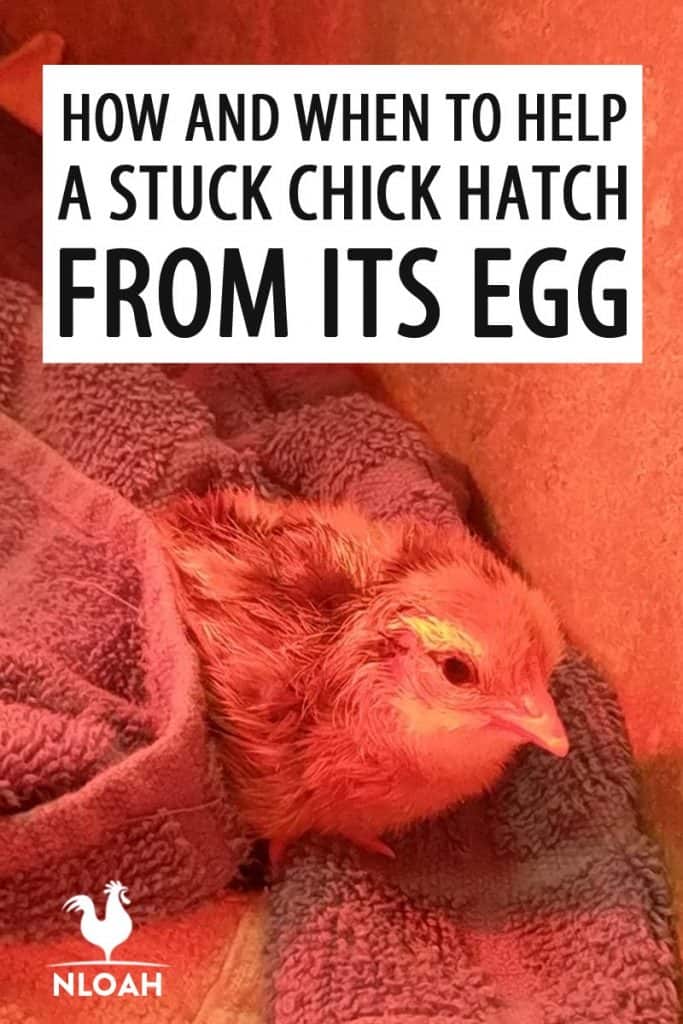

Tara lives on a 56 acres farm in the Appalachian Mountains, where she faces homesteading and farming challenges every single day, raising chickens, goats, horses, and tons of vegetables. She’s an expert in all sorts of homesteading skills such as hide tanning, doll making, tree tapping, and many more.

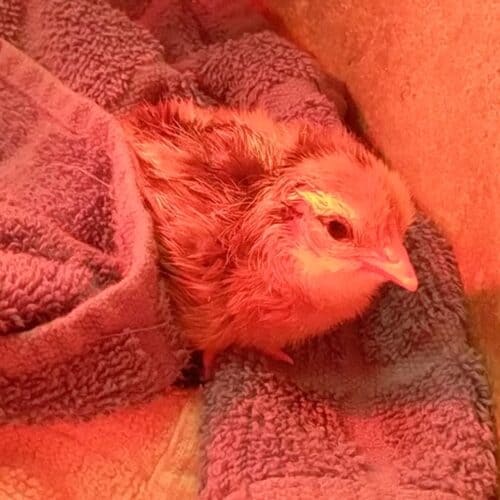
I think it is so cute when you hear the chicks chirping but only have a tiny hole to breath out of. My chicks started pipping at 19 days of incubation, I have about 20 that are pipping already and another 14 that haven’t started. But every time I go in there to check I see more have started. My first 2 chicks are drying and warming and doing good. Now the rest need to hurry up so I can move everyone to the trough where I set up their home for the next month or so, or until they start getting out. I am going to use an old trampoline frame to house them until they get bigger. just wrap it in chicken wire, put wire on the ground and put some type of cover over the top. (DON’T FORGET A GATE SO YOU CAN GET IN) That way they will be safe from predators, put some type of house and something off the ground for them to roost in and on. Now they will be safe until they can go in the chicken yard with the big girls and boys.
Thats interesting but very different from my experience. I have helped lots of lethargic chicks hatch and they are just fine. Its a slow process because you need to remove the egg little by little so they don’t bleed to death but I have had no issues. If they are struggling there is no need for them to die if you give them a little help.
I’ve used a heating pad and do have the right temp I’ve turned them.will they hatch they are guineas.
Thank you! I helped an egg hatch thanks to your instructions & I think the chick is doing great! Only time will tell!
Hey there,
I have a chick that zipped about an hour ago. The zip turned to the bottom from other chicks bumping the egg. Should I turn it up or will it be able to get out on its own still
My chick has been trying to get out of his egg for 3 days now. It is peeping but not pecking at the egg. I tried helping him but the shell is really hard. My other chicks all hatched 2 days prior to this chick. What can I do?
Wow, I wish I’d found your page sooner…think I’ve compromised my other chicks by leaping in too soon to help another one out…so angry at myself for being so impatient ? I will definitely take on your tips for the next time though…thank you